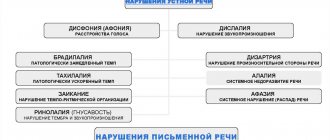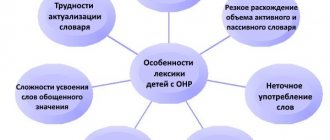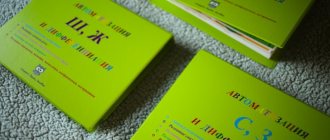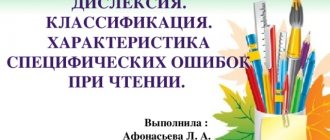Classification
There are two forms of dyslalia:
- mechanical;
- functional.
With mechanical, a person cannot pronounce words correctly due to defects in the articulation apparatus, which appear as a result of injuries, diseases, or are congenital. With functional dyslalia there are no organic defects of the speech apparatus; it can develop due to a violation of phonemic perception, in certain social conditions and can be corrected. Functional dyslalia is classified into
- motor (characterized by a disorder in the sections of the speech motor analyzer),
- sensory (impairment in the sections of the speech-hearing analyzer),
- sensorimotor (has signs of the first two types).
Dyslalia is also divided according to the nature of the defect. The degree of complexity of the violation is determined by the number of incorrectly pronounced sounds; more than 4 are considered complex.
Incorrect pronunciation of one group of sounds is called monomorphic dyslalia. If the disorder extends to several different groups, it is polymorphic dyslalia.
Disadvantages of pronunciation of individual sounds
| Defective sound | Phonetic defect (sound distortion) | Phonemic defect (confusion, sound replacement) | ||
| Name of pronunciation defect | Types of defective pronunciation | Name of pronunciation defect | Types of substitutions | |
| Sound R | Rotacism | Velar, uvular, lateral, buccal, single-impact, “coachman” | Pararotacism | Р = Р' Р = Л' Р = J Р = Г Р =Д |
| Sound L Sound L' | Lambdacism | Bilabial, softened | Paralambdacism | L = Y L = G L = L' L = R |
| Sounds S, S' Sounds Z, Z' Sound C | Sigmatism | Interdental, labial-dental, lateral, subdental, sibilant | Parasigmatism | S, Z, C = W S, Z, C = F S, Z, C = T S, Z, C = Shch S - W; C = H |
| Sound Ш Sound Ж Sound Ш Sound Ш | Sigmatism | Mesdental, buccal, lateral, “lower”, posterior lingual, softened, shortened, affricative | Parasigmatism | Sh, Zh, Shch = T Sh, Zh, Shch = F Zh = Sh Zh = Z Shch = S' Sh = Shch Ch = T'; Ch = Sh' |
| Sound j | Yotacism | Soft lower and upper articulation | Paraiotacism | J = L' |
| Sounds K, K | Kappacism | Vocal, laryngeal | Paracapacism | K = T |
| Sounds G, G | Gammacism | Fricative velar, pharyngeal | Paragammatism | G = T |
| Sounds X, X | Hitism | Vocal, laryngeal | Parachytism | |
Terminology of phonetic distortions
Speech development defects in which the child does not pronounce [r] or [r'] are rhotacism; if they distort [l] and [l'] this is lambdacism, difficulties with hissing sounds [zh], [sh], [sch] , [h] and whistling [s], [s'], [z], [z'] is called sigmatism, iotacism is a problem with the pronunciation of [th], gammacism is a distortion of [g] and [g'], kappacism is difficulties in pronunciation [k] and [k'], hitism - problems with the sound [x] and [x']. Speech defects such as voicing of deaf consonants or deafening of voiced consonants, as well as the replacement of hard with soft consonants and vice versa, are also observed.
Names of phonetic defects and their types (table)
All types of pronunciation deficiencies can be presented schematically for clarity:
Distortions of the sound-syllable structure of words in children with speech pathology
Evgenia Erokhova
Distortions of the sound-syllable structure of words in children with speech pathology
Among the various speech disorders in preschool children
One of the most difficult to correct is such a special manifestation of speech pathology as a violation of the syllabic structure of words . This defect in speech development is characterized by difficulties in pronouncing words of complex syllabic composition (violation of the order of syllables in a word , omissions or addition of new syllables or sounds )
Violation of the sound-syllable structure of words is usually detected when
therapy examination of children with general speech underdevelopment, but it can also occur in children suffering only from phonetic-phonemic
underdevelopment. As a rule, the range of these violations varies widely: from minor difficulties in pronouncing words of a complex syllabic structure in conditions of spontaneous speech to severe violations when a child repeats two- and three-syllable words without a combination of consonants, even with the help of visual aids.
The issue of the formation of the sound-syllable structure of a word in ontogenesis and
specialists from various
regions (A. I. Sikorsky, V. K. Orfinskaya, L. A. Chistovich, A. N. Gvozdev, R. E. Levina, A. A. Leontyev, A. R. Luria, etc.). also in
Methods for overcoming violations are widely presented in the literature.
sound-syllable structure of words in children (Z. E. Agranovich, G. G. Golubeva,
T. A. Titova, A. K. Markova, etc.).
All authors note that a violation of the sound-syllable structure of a word in
for children with speech pathology , which makes it difficult to master oral and, subsequently, written speech, is quite persistent and difficult to overcome. The problem of violation and correction of the sound-syllable structure of a word
most authors study in children with motor alalia (G.V. Gurovets
L. B. Esechko, R. E. Levina, A. K. Markova, O. N. Usanova, etc.). Speech
the symptoms of alalia are expressed in difficulties in mastering language
patterns and their incorrect use, in agrammatisms,
distortions of the sound-syllable structure of a word (omission of letters, rearrangements
syllables, insertion of additional vowels, etc., violation
, etc. d.
In accordance with the principles of psychological and pedagogical classification
speech disorders, a category of children with general underdevelopment of speech (GSD, in which there is insufficient formation of all language structures . Speech suffers as an integral functional
system, all its components are violated: the phonetic-phonemic side, vocabulary, grammatical structure.
Researchers (A.K. Markova, L.N. Efimenkova, G.A. Kashe,
L. V. Lopatina, O. V. Pravdina, N. V. Serebryakova, T. A. Titova
, T. V. Tumanova, T. B. Filicheva, G. V. Chirkina, A. V. Yastrebova)
While studying the speech of preschool children with SLD, they note that their speech is characterized by insufficient phonetic design. Children with OHP have polymorphic disturbances in sound pronunciation , unformed processes of differentiation of acoustically or articulatory similar sounds , as well as disturbances in the sound-syllable composition of a word . Violations of the syllabic structure of the word are retained in speech
preschoolers with OHP last longer than the deficiencies in the pronunciation of individual sounds .
The syllabic structure of a word , acquired in isolated pronunciation, is often distorted again when the word is included in a phrase or independent speech. The specificity of a systemic speech disorder of general underdevelopment of speech is a violation of the sound-syllable structure of a word : substitutions, omissions, rearrangements, repetition of sounds and syllables , anticipation, contamination.
These disorders are varied and inconsistent in their manifestation (from
minor difficulties to serious violations): often wear persistent and
long-term in nature, delay the process of normal development of oral speech.
A child with general speech underdevelopment cannot independently master
sound-syllable structure of the word . It is believed that the sensitive age for the most successful overcoming of these disorders is preschool. But if these violations are not corrected in a timely manner, then this leads to violations of all speech components : vocabulary, grammar, coherent speech.
According to modern researchers G.V. Babina, N. Yu.
Safonkina, the pathogenesis of this type of disorder is distortion
formation of the sensorimotor repertoire of individual systems and their
interactions, including the rhythmic structure of words . This speaks of
deficient or unformed status of specific brain systems.
Specialists in the field of psycholinguistics V. Glukhov and V. Kovshikov
they say that in order to fully master a language, the maturation of very specific structures of the nervous system and the formation of certain connections between them are required. This position is confirmed, in particular, by various forms of pathology of the nervous system . For example, many children with cerebral palsy (in this case we are talking about children whose cerebral palsy is not complicated by other disorders of the nervous system that can lead to impairments in the acquisition of language as a sign system) master language as a sign system, although they usually have articular disorders, sometimes heavy.
In addition, the child must have formed peripheral
articular and auditory apparatus, allowing him to speak and perceive addressed speech. However, as N. S. Derzhavin notes, even with significant deformations of the peripheral articular apparatus, for example, with cleft lips and palate (hard and soft), the child learns language as a sign system (in this case, the child usually exhibits pronounced disturbances in sound pronunciation and prosody )
The situation is different with hearing impairment. Average and
severe hearing loss naturally leads to pathological
development of all components of language: not only phonetic and
phonemic, but also semantic, as well as syntactic, lexical, morphological and morpho-syntactic.
For many children with phonetic-phonemic, and even more so general
Underdevelopment of speech is characterized by difficulties in learning new words . This
is expressed not only in the later dates of the appearance of words in the child’s speech and their small number, but also in the child’s difficulties in understanding the meanings of words and distortion of their sound-syllable structure . Violation of the formation of phonemic analysis manifests itself in specific errors when reading: letter-by-letter reading, distortion of the sound-syllable structure of a word .
In phonemic dyslexia, there is letter-by-letter reading,
distortion of the sound-syllable structure of words , frequent errors: omissions of consonants during confluence, rearrangements of sounds , omissions and rearrangements of syllables.
Thus, R.I. Lalaeva points out that the most common
errors in dyslexia and dysgraphia are distortions of sound syllables
word structures . The decomposition of a word into its constituent phonemes is a complex mental activity. In mentally retarded children, it is this form of language analysis and synthesis that suffers the most. In children with dyslexia, the following main types of errors are observed during the reading process: replacement and confusion of sounds when reading (replacement of phonetically close sounds , including voiced - voiceless and others, replacement
letters by optical similarity, letter-by-letter reading (violation of the merging of sounds into syllables and words , distortion of the sound-syllable structure of a word (manifested in omissions of consonants when converging, omissions of consonants and vowels in the absence of confluence, adding sounds , rearranging sounds , omissions and rearrangements of syllables) V. Glukhov , V. Kovshikov also indicate that with dyslexia there are
distortion of the sound-syllable structure of a word . Most common
errors from this group:
a) omission of vowels during the confluence (bench - kameika)
;
b) omissions of consonants and vowels in the absence of a confluence (locomotive -
parvoz); c) adding sounds (in the rain - in the rain)
;
d) rearrangement of sounds (shovel - lotapa)
;
e) omissions, rearrangements of syllables (kanava - kavana)
Summarizing the literature data on speech disorders in children with mental retardation ,
R.I. Lalaeva points out that the expressive speech of these children
These are not only problems with sound pronunciation ; In many cases
the picture indicates the presence of a general underdevelopment of speech, a delay
process of speech development . Impressive speech is characterized by
insufficiency of differentiation of speech-auditory perception .
Among other speech disorders, children with mental retardation also have
the sound-syllable structure of the word is also disrupted , which prevents assimilation
vocabulary and grammatical structure of speech. Not only in oral speech, but also in the process of reading and writing, children with mental retardation allow various kinds of distortions of the sound-syllable structure of a word . Frequent mistakes include omissions, rearrangements, additions of sounds and syllables . The greatest difficulty is caused by syllables with a combination of consonants and syllables with soft consonants.
Overcoming dyslalia
Correction of dyslalia is complex. and consists of a number of successive stages:
- preparatory (includes articulatory gymnastics, work on respiratory and vocal function, development of fine motor skills, synchronization of speech with movement, formation of spatial concepts and spatial-analytical activity);
- staging stage;
- stage of automation of delivered sounds;
- the stage of differentiation of articulatory and acoustically similar speech sounds.






